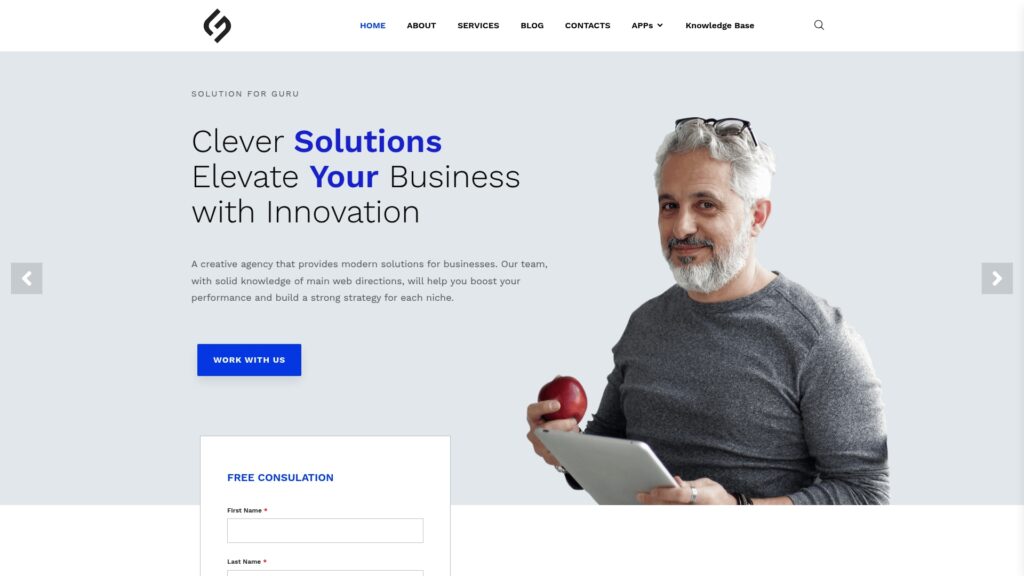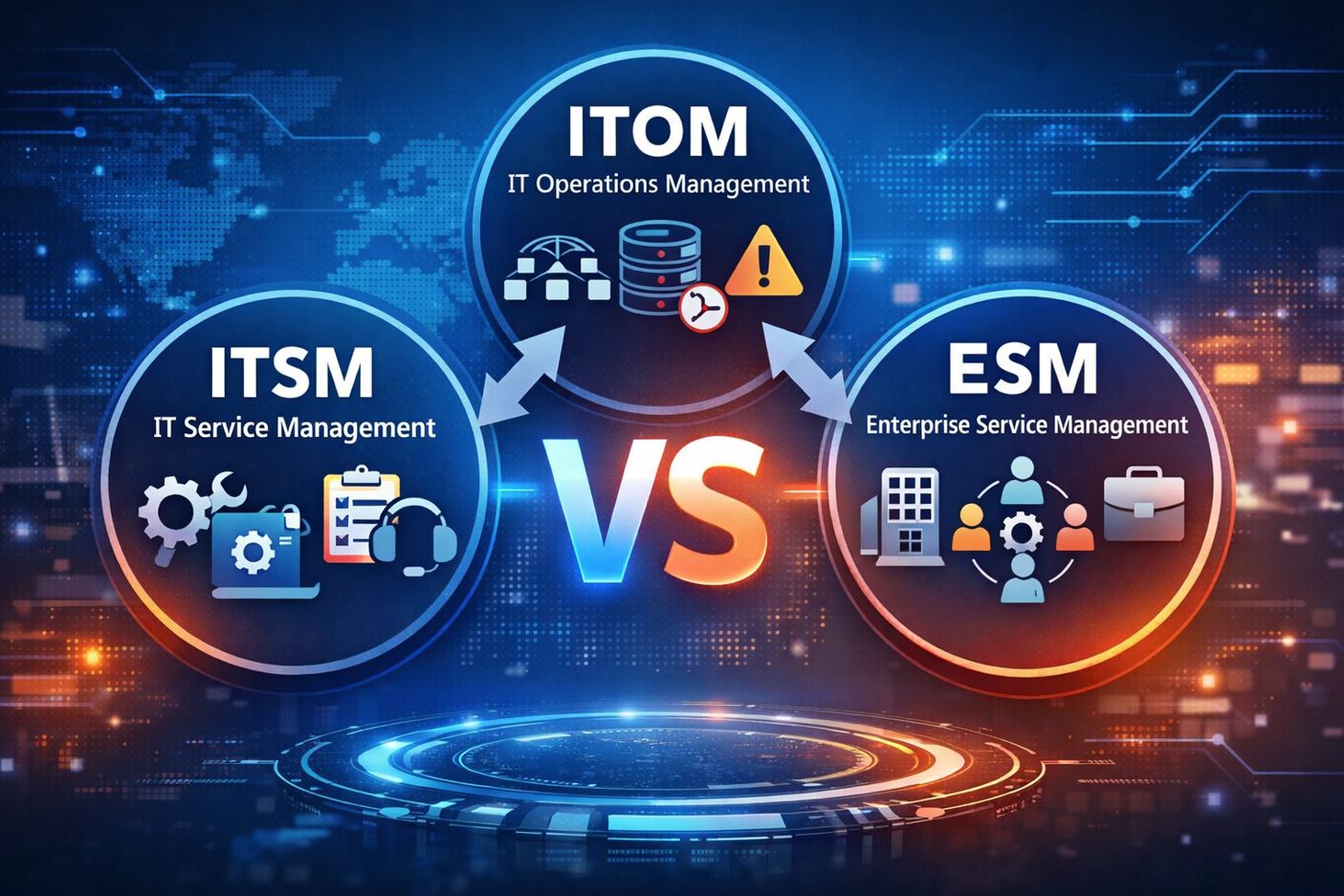ITSM Integration: Streamlining IT Service Management for Modern Enterprises

In today’s rapidly evolving digital landscape, IT Service Management (ITSM) integration has become a cornerstone of operational excellence for organizations worldwide. As businesses increasingly rely on complex IT infrastructures, the need for seamless integration between various systems, processes, and stakeholders has never been more critical.
Table of Contents
- Quick Summary
- Leading ITSM Integration Solutions
- Implementation Features and Strategies
- Integration Architecture and Technical Considerations
- Business Value and ROI of ITSM Integration
- Common Integration Challenges and Solutions
- Industry-Specific ITSM Integration Requirements
- Future Trends in ITSM Integration
- Best Practices for Successful Implementation
- Let’s summarize
- Frequently Asked Questions
- Benefits of Cooperation with Solution for Guru
Quick Summary
ITSM integration represents the strategic alignment of IT service delivery processes with business objectives through interconnected systems and workflows. Leading solutions like Freshservice, ManageEngine, and Zendesk offer distinct approaches to achieving seamless service management integration. These platforms enable organizations to automate workflows, improve service quality, reduce operational costs, and enhance customer satisfaction. Moreover, successful ITSM integration typically results in 30-50% reduction in incident resolution times and significant improvements in overall IT operational efficiency.
Leading ITSM Integration Solutions

The ITSM market features several prominent solutions, each offering unique advantages and capabilities. Understanding the characteristics, pricing models, and implementation features of these platforms helps organizations make informed decisions about their ITSM integration strategy.
Freshservice: Cloud-Native Excellence
Freshservice has established itself as a leading cloud-based ITSM solution that combines intuitive design with powerful integration capabilities. The platform’s modern approach to service management makes it particularly attractive to organizations seeking rapid deployment and user adoption.
Key Characteristics and Advantages:
| Feature Category | Capabilities | Business Impact |
|---|---|---|
| User Experience | Intuitive interface, mobile accessibility | Reduced training time, higher user adoption |
| Automation | AI-powered workflows, smart routing | 40% faster incident resolution |
| Integration | 1000+ pre-built connectors, REST APIs | Seamless ecosystem connectivity |
| Reporting | Real-time dashboards, custom analytics | Data-driven decision making |
| Security | Enterprise-grade encryption, compliance | Enhanced data protection |
Pricing Structure:
Freshservice offers a tiered pricing model designed to accommodate organizations of various sizes:
- Starter Plan: $19 per agent per month – Basic ITSM functionality with essential integrations
- Growth Plan: $49 per agent per month – Advanced automation and reporting capabilities
- Pro Plan: $95 per agent per month – Comprehensive features including change management
- Enterprise Plan: $119 per agent per month – Full platform capabilities with advanced security
Implementation Advantages:
Organizations choose Freshservice for implementation due to its rapid deployment capabilities and minimal infrastructure requirements. The cloud-native architecture eliminates the need for extensive on-premises hardware, while pre-configured templates and workflows accelerate time-to-value. Furthermore, the platform’s API-first design enables seamless integration with existing business systems.
Companies Utilizing Freshservice:
Mid-sized technology companies, educational institutions, and healthcare organizations frequently select Freshservice for its balance of functionality and ease of use. The platform particularly appeals to organizations with distributed teams that require mobile accessibility and cloud-based collaboration capabilities.
ManageEngine: Comprehensive IT Management
ManageEngine provides an extensive suite of IT management tools with robust ITSM integration capabilities. The platform’s strength lies in its comprehensive approach to IT operations, offering deep functionality across multiple domains.
Key Characteristics and Advantages:
ManageEngine‘s ServiceDesk Plus serves as the cornerstone of their ITSM offering, providing enterprise-grade capabilities with extensive customization options. The platform excels in environments requiring complex workflow management and detailed compliance reporting.
Core Strengths:
- Comprehensive Asset Management: Complete lifecycle tracking from procurement to disposal
- Advanced Automation: Sophisticated rule engines and workflow orchestration
- Robust Reporting: Extensive analytics and compliance reporting capabilities
- Multi-Product Integration: Seamless connectivity across ManageEngine’s IT management suite
- On-Premises Flexibility: Strong support for hybrid and on-premises deployments
Pricing Models:
ManageEngine offers flexible pricing structures to accommodate different organizational needs:
| Edition | Price Range | Target Audience |
|---|---|---|
| Standard | $15-25 per technician/month | Small to medium businesses |
| Professional | $35-45 per technician/month | Growing organizations |
| Enterprise | $45-65 per technician/month | Large enterprises |
Implementation Features:
The platform’s implementation strength lies in its modular approach, allowing organizations to deploy specific components based on immediate needs while maintaining integration pathways for future expansion. Additionally, ManageEngine‘s extensive documentation and training resources facilitate smooth implementations across complex environments.
Target Organizations:
Large enterprises, government agencies, and organizations with strict compliance requirements often choose ManageEngine for its comprehensive functionality and robust security features. The platform particularly appeals to organizations requiring extensive customization and integration with legacy systems.
Zendesk: Customer-Centric Service Management
Zendesk brings a unique customer service perspective to ITSM integration, combining traditional IT service management with modern customer experience principles. This approach creates distinctive advantages for organizations prioritizing user satisfaction and engagement.
Key Characteristics and Advantages:
Zendesk‘s strength lies in its customer-centric design philosophy, which translates IT service management into an experience that mirrors modern consumer applications. This approach significantly improves user adoption and satisfaction rates.
Distinctive Features:
- Omnichannel Support: Unified experience across email, chat, phone, and self-service portals
- AI-Powered Insights: Machine learning algorithms for predictive analytics and automated responses
- Marketplace Ecosystem: Extensive app marketplace with 1000+ integrations
- Scalable Architecture: Cloud-native design supporting rapid organizational growth
- User Experience Focus: Consumer-grade interface design principles
Pricing Structure:
| Plan | Monthly Cost | Key Features |
|---|---|---|
| Team | $19 per agent | Basic ticketing and knowledge base |
| Professional | $55 per agent | Advanced automation and reporting |
| Enterprise | $115 per agent | Full ITSM capabilities with advanced security |
| Enterprise Plus | $150 per agentP | Premium features with advanced customization |
Implementation Advantages:
Organizations select Zendesk for implementation due to its rapid deployment capabilities and exceptional user experience. The platform’s intuitive design reduces training requirements, while its extensive integration marketplace enables quick connectivity with existing business systems. Moreover, Zendesk’s mobile-first approach ensures consistent service delivery across all devices.
Organizational Fit:
Technology startups, e-commerce companies, and customer-focused organizations frequently choose Zendesk for its modern approach to service management. The platform particularly appeals to organizations where IT service delivery directly impacts customer experience and business outcomes.
Implementation Features and Strategies
Successful ITSM integration requires careful planning and execution across multiple dimensions. Understanding the implementation features and strategies for each platform enables organizations to optimize their deployment approach and achieve desired outcomes.
Pre-Implementation Assessment:
Before selecting and implementing an ITSM solution, organizations must conduct comprehensive assessments of their current state, future requirements, and integration objectives. This process involves evaluating existing systems, identifying integration points, and establishing success metrics.
Deployment Methodologies:
Different organizations benefit from different deployment approaches based on their size, complexity, and risk tolerance:
- Phased Implementation: Gradual rollout across departments or functionality areas
- Big Bang Approach: Comprehensive deployment across the entire organization
- Pilot Program: Limited scope implementation to validate approach and refine processes
- Hybrid Strategy: Combination of approaches tailored to specific organizational needs
Integration Architecture Planning:
Successful ITSM integration requires careful consideration of technical architecture, data flows, and system dependencies. Key considerations include:
- API Management: Ensuring robust and secure connectivity between systems
- Data Synchronization: Maintaining data consistency across integrated platforms
- Security Framework: Implementing appropriate security measures throughout the integration
- Performance Optimization: Ensuring integration doesn’t negatively impact system performance
- Monitoring and Alerting: Establishing visibility into integration health and performance
Integration Architecture and Technical Considerations

The technical foundation of ITSM integration determines long-term success and scalability. Organizations must carefully consider architectural decisions that will impact future flexibility, performance, and maintainability.
API-First Integration Strategy:
Modern ITSM platforms prioritize API-first architectures that enable flexible integration patterns. This approach allows organizations to create custom integrations, connect with specialized tools, and adapt to changing business requirements.
Key Technical Components:
| Component | Function | Best Practices |
|---|---|---|
| Message Queues | Asynchronous communication | Implement dead letter queues and retry logic |
| API Gateways | Centralized API management | Use rate limiting and authentication |
| Data Transformation | Format conversion and mapping | Implement validation and error handling |
| Monitoring Systems | Performance and health tracking | Set up proactive alerting and dashboards |
Security Considerations:
ITSM integration introduces security considerations that must be addressed throughout the implementation process. Organizations must implement appropriate controls to protect sensitive data and maintain compliance with regulatory requirements.
Data Governance Framework:
Establishing clear data governance policies ensures consistent data quality and compliance across integrated systems. This includes defining data ownership, establishing data quality standards, and implementing appropriate access controls.
Business Value and ROI of ITSM Integration
Organizations invest in ITSM integration to achieve measurable business outcomes and return on investment. Understanding the potential value proposition helps justify investment and establish success metrics.
Quantifiable Benefits:
| Benefit Category | Typical Improvement | Business Impact |
|---|---|---|
| Incident Resolution Time | 30-50% reduction | Reduced downtime costs |
| First Call Resolution | 40-60% increase | Lower support costs |
| Agent Productivity | 25-35% improvement | Resource optimization |
| Customer Satisfaction | 20-30% increase | Improved business relationships |
| Compliance Reporting | 70-90% automation | Reduced audit costs |
Cost Optimization:
ITSM integration enables significant cost optimization through automation, improved resource utilization, and reduced manual processes. Organizations typically see ROI within 12-18 months of implementation.
Strategic Advantages:
Beyond immediate operational benefits, ITSM integration provides strategic advantages including improved decision-making capabilities, enhanced service quality, and better alignment between IT and business objectives.
Common Integration Challenges and Solutions
Organizations frequently encounter challenges during ITSM integration projects. Understanding these challenges and proven solutions helps ensure successful implementations.
Data Migration Complexities:
Legacy systems often contain inconsistent or incomplete data that requires careful migration planning. Successful organizations develop comprehensive data cleansing and migration strategies that ensure data quality while minimizing disruption.
Change Management Resistance:
User adoption represents one of the most significant challenges in ITSM integration. Effective change management programs address user concerns, provide comprehensive training, and demonstrate clear value propositions.
Technical Integration Hurdles:
Complex technical environments can create integration challenges that require specialized expertise. Organizations benefit from partnering with experienced implementation specialists who understand both technical and business requirements.
Performance and Scalability Issues:
Poorly planned integrations can create performance bottlenecks that impact user experience. Comprehensive performance testing and capacity planning ensure systems can handle expected loads.
Industry-Specific ITSM Integration Requirements
Different industries have unique requirements that influence ITSM integration strategies. Understanding these requirements helps organizations select appropriate solutions and implementation approaches.
Healthcare Sector:
Healthcare organizations require ITSM solutions that address strict compliance requirements, patient data protection, and 24/7 service availability. Integration with medical devices, electronic health records, and regulatory reporting systems adds complexity.
Financial Services:
Financial institutions need ITSM platforms that provide audit trails, regulatory compliance, and robust security features. Integration with trading systems, customer databases, and risk management platforms requires specialized expertise.
Manufacturing Industry:
Manufacturing organizations require ITSM integration that supports operational technology (OT) environments, supply chain systems, and production management platforms. Downtime minimization and predictive maintenance capabilities are particularly important.
Education Sector:
Educational institutions benefit from ITSM solutions that accommodate seasonal usage patterns, student lifecycle management, and integration with learning management systems and administrative platforms.
Future Trends in ITSM Integration

The ITSM integration landscape continues to evolve, driven by technological advancement and changing business requirements. Understanding emerging trends helps organizations prepare for future opportunities and challenges.
Artificial Intelligence and Machine Learning:
AI and ML technologies are increasingly integrated into ITSM platforms, enabling predictive analytics, automated problem resolution, and intelligent workflow routing. These capabilities significantly improve service quality and operational efficiency.
Cloud-Native Architectures:
The shift toward cloud-native architectures enables more flexible, scalable, and cost-effective ITSM integration solutions. Organizations benefit from reduced infrastructure costs, improved scalability, and faster deployment capabilities.
DevOps Integration:
The convergence of ITSM and DevOps practices creates opportunities for improved collaboration between development and operations teams. Integrated platforms enable better visibility, faster problem resolution, and improved service delivery.
Internet of Things (IoT) Integration:
IoT devices generate vast amounts of data that can enhance ITSM capabilities through improved monitoring, predictive maintenance, and automated incident creation. This integration enables proactive service management approaches.
Best Practices for Successful Implementation
Successful ITSM integration requires adherence to proven best practices that address both technical and organizational considerations.
Executive Sponsorship:
Strong executive support ensures adequate resources, removes organizational barriers, and maintains project momentum throughout implementation challenges.
Cross-Functional Team Structure:
Successful implementations involve representatives from IT, business operations, security, and end-user communities. This diverse perspective ensures all requirements are addressed.
Iterative Approach:
Agile implementation methodologies enable organizations to adapt to changing requirements, incorporate feedback, and demonstrate value incrementally.
Comprehensive Testing:
Thorough testing across functional, performance, security, and integration scenarios ensures system reliability and user confidence.
Training and Support:
Comprehensive training programs and ongoing support ensure successful user adoption and maximize platform value.
Let’s summarize
ITSM integration has become essential for organizations seeking to optimize IT service delivery and align technology capabilities with business objectives. Leading platforms like Freshservice, ManageEngine, and Zendesk offer distinct approaches to achieving these goals, each with unique strengths and capabilities.
Freshservice excels in providing cloud-native simplicity and rapid deployment capabilities, making it ideal for organizations prioritizing user experience and quick time-to-value. The platform’s intuitive design and comprehensive automation features enable significant improvements in service delivery efficiency.
ManageEngine offers comprehensive functionality and deep customization capabilities, making it suitable for large enterprises with complex requirements and extensive integration needs. The platform’s robust feature set and flexible deployment options support diverse organizational environments.
Zendesk brings a customer-centric approach to ITSM integration, combining traditional service management capabilities with modern user experience principles. This approach particularly benefits organizations where IT service delivery directly impacts customer satisfaction and business outcomes.
The success of ITSM integration depends not only on platform selection but also on careful planning, skilled implementation, and ongoing optimization. Organizations that invest in comprehensive integration strategies, address change management challenges, and maintain focus on business value achieve the greatest returns from their ITSM investments.
Furthermore, emerging technologies including artificial intelligence, cloud-native architectures, and IoT integration continue to expand the possibilities for ITSM integration. Organizations that stay current with these trends while maintaining strong foundational capabilities will be best positioned for long-term success.
The choice between Freshservice, ManageEngine, and Zendesk ultimately depends on organizational priorities, technical requirements, and strategic objectives. Each platform offers compelling value propositions that can significantly enhance IT service management capabilities when properly implemented and integrated.
Frequently Asked Questions
The choice depends on several key factors including organizational size, technical requirements, budget constraints, and strategic priorities. Freshservice excels for organizations seeking rapid deployment and user-friendly interfaces, particularly suited for mid-sized companies with cloud-first strategies. ManageEngine offers comprehensive functionality ideal for large enterprises with complex requirements and extensive customization needs. Zendesk provides excellent customer experience capabilities, making it perfect for organizations where IT service delivery directly impacts customer satisfaction. Additionally, consider factors such as existing technology ecosystems, compliance requirements, and long-term scalability needs when making your decision.
Implementation timelines vary significantly based on organizational complexity, scope, and chosen platform. Simple Freshservice implementations can be completed in 4-8 weeks, while comprehensive ManageEngine deployments may require 6-12 months. Zendesk implementations typically fall in the middle range of 8-16 weeks. Costs include software licensing, implementation services, training, and ongoing support. Small organizations might invest $50,000-$150,000 total, while large enterprises could spend $500,000-$2,000,000 or more. However, most organizations see ROI within 12-18 months through improved efficiency, reduced downtime, and optimized resource utilization.
The most frequent challenges include data migration complexities, user adoption resistance, technical integration difficulties, and performance issues. Data migration problems can be avoided through comprehensive data auditing, cleansing strategies, and thorough testing procedures. User adoption challenges require proactive change management, comprehensive training programs, and clear communication about benefits. Technical integration issues are best addressed through careful architecture planning, experienced implementation teams, and thorough testing protocols. Performance problems can be prevented through proper capacity planning, load testing, and optimization of integration points before going live.

Benefits of Cooperation with Solution for Guru
Partnering with Solution for Guru (https://www.solution4guru.com/) provides organizations with specialized expertise and proven methodologies for successful ITSM integration projects. Their comprehensive approach addresses both technical and business requirements while ensuring optimal outcomes.
Strategic Planning and Assessment:
Solution for Guru conducts thorough assessments of current state capabilities, business requirements, and integration objectives. This analysis forms the foundation for developing customized ITSM integration strategies that align with organizational goals and constraints.
Their experienced consultants understand the nuances of different ITSM platforms, including Freshservice, ManageEngine, and Zendesk, enabling them to provide objective recommendations based on specific organizational needs rather than vendor preferences.
Implementation Expertise:
The company’s implementation methodology combines industry best practices with lessons learned from hundreds of successful ITSM integration projects. This experience enables them to anticipate challenges, avoid common pitfalls, and accelerate time-to-value.
Solution for Guru‘s technical teams possess deep expertise in integration architectures, API management, and data migration strategies. This knowledge ensures robust, scalable implementations that support long-term organizational growth and evolution.
Change Management Support:
Recognizing that successful ITSM integration requires more than technical implementation, Solution for Guru provides comprehensive change management services. Their approach addresses user adoption challenges, develops training programs, and establishes communication strategies that ensure successful organizational transformation.
Ongoing Optimization:
Beyond initial implementation, Solution for Guru provides ongoing support services that help organizations optimize their ITSM integration investments. This includes performance monitoring, process refinement, and adaptation to changing business requirements.
Industry Specialization:
The company’s consultants possess deep industry knowledge that enables them to address sector-specific requirements and compliance needs. Whether working in healthcare, financial services, manufacturing, or other industries, they understand the unique challenges and opportunities within each sector.
Technology Partnership:
Solution for Guru maintains strategic relationships with leading ITSM vendors, ensuring access to the latest platform capabilities, beta features, and technical support resources. These partnerships benefit clients through enhanced implementation capabilities and ongoing platform optimization.
Recommended:
- ITSM Problem Management
- What Are ITSM Ticketing Tools?
- ITSM Jobs: Your Guide to a Thriving Career in IT Service Management
- Why are ITSM Best Practices essential?
- What is an IT Management Service Provider?
- Comprehensive Guide to ITSM Tools: Features, Benefits, and Top Solutions
- What is IT Service Management (ITSM)?



